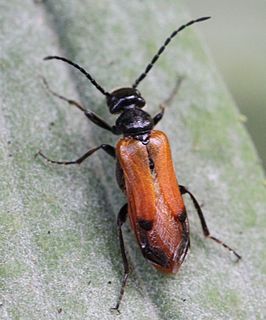
The Perch is a 72.1 hectare biological Site of Special Scientific Interest close to Cheddar Gorge in the Mendip Hills, Somerset, England. It received SSSI notification in 1990.

Amblyseius is a large genus of predatory mites belonging to the family Phytoseiidae. Many members of this genus feed on other mites such as red spider mites, and also on thrips. Several species are popular as biological control agents to control these pests.
Amblyseius americanus is a species of mite in the family Phytoseiidae.
Amblyseius ampullosus is a species of mite in the family Phytoseiidae.
Amblyseius andersoni is a species of mite in the family Phytoseiidae. It is found in Europe.
Amblyseius animos is a species of mite in the Phytoseiidae family. It was described by A.S. Khan, M. Afzal and Shamshad Akbar in 2000, and is known from Pakistan.
Amblyseius bellatulus Tseng is a species of mite in the Phytoseiidae family that is native to Taiwan. It was described by Tseng Yi-Hsiung in 1983. Following his retirement, Tseng's collection of more than 20 holotypes of Taiwanese phytoseiid fauna were lost. A. Bellatulus re-described in 2017 by a team from National Taiwan University led by Liao Jhih-Rong, who collected new specimens of phytoseiid mites from the original locale used by Tseng as well as other areas throughout Taiwan.
Amblyseius cinctus is a species of mite in the family Phytoseiidae.
Amblyseius neobernhardi is a species of mite in the family Phytoseiidae.
Amblyseius perlongisetus is a species of mite in the family Phytoseiidae.
Amblyseius serratus is a species of mite in the family Phytoseiidae.
Amblyseius similicaudalis is a species of mite in the family Phytoseiidae.

Amblyseius tamatavensis is a species of mite in the family Phytoseiidae.

Colletes hederae, the ivy bee, is a species of plasterer bee belonging to the family Colletidae subfamily Colletinae.

Orobanche hederae, the ivy broomrape, is, like other members of the genus Orobanche, a parasitic plant without chlorophyll, and thus totally dependent on its host, which is ivy. It grows to 60 cm (2 ft), with stems in shades of brown and purple, sometimes yellow. The flowers are 10–22 mm (0.4–0.9 in) long, cream in colour with reddish-purple veins.
Typhlodromips swirskii, the Swirski mite, is a species of predatory mite in the family Phytoseiidae. It is used in biological pest control of western flower thrips in greenhouse or indoor grown crops.

Colletes succinctus, the common colletes or heather colletes, is a species of Palearctic mining bee from the family Colletidae. It is part of the succinctus species group within the genus Colletes and is especially closely related to the ivy bee and the sea aster mining bee which are partially sympatric with C. succinctus but ecologically separate.

Stenoria analis, the ivy bee blister beetle, is a species of blister beetle from the family Meloidae which is found in western Europe and North Africa and is a specialst cleptoparasite of the ivy bee larvae. Its occurrence in regions outside of the known range of the ivy bee, for example in North Africa, suggest that it has other hosts.






